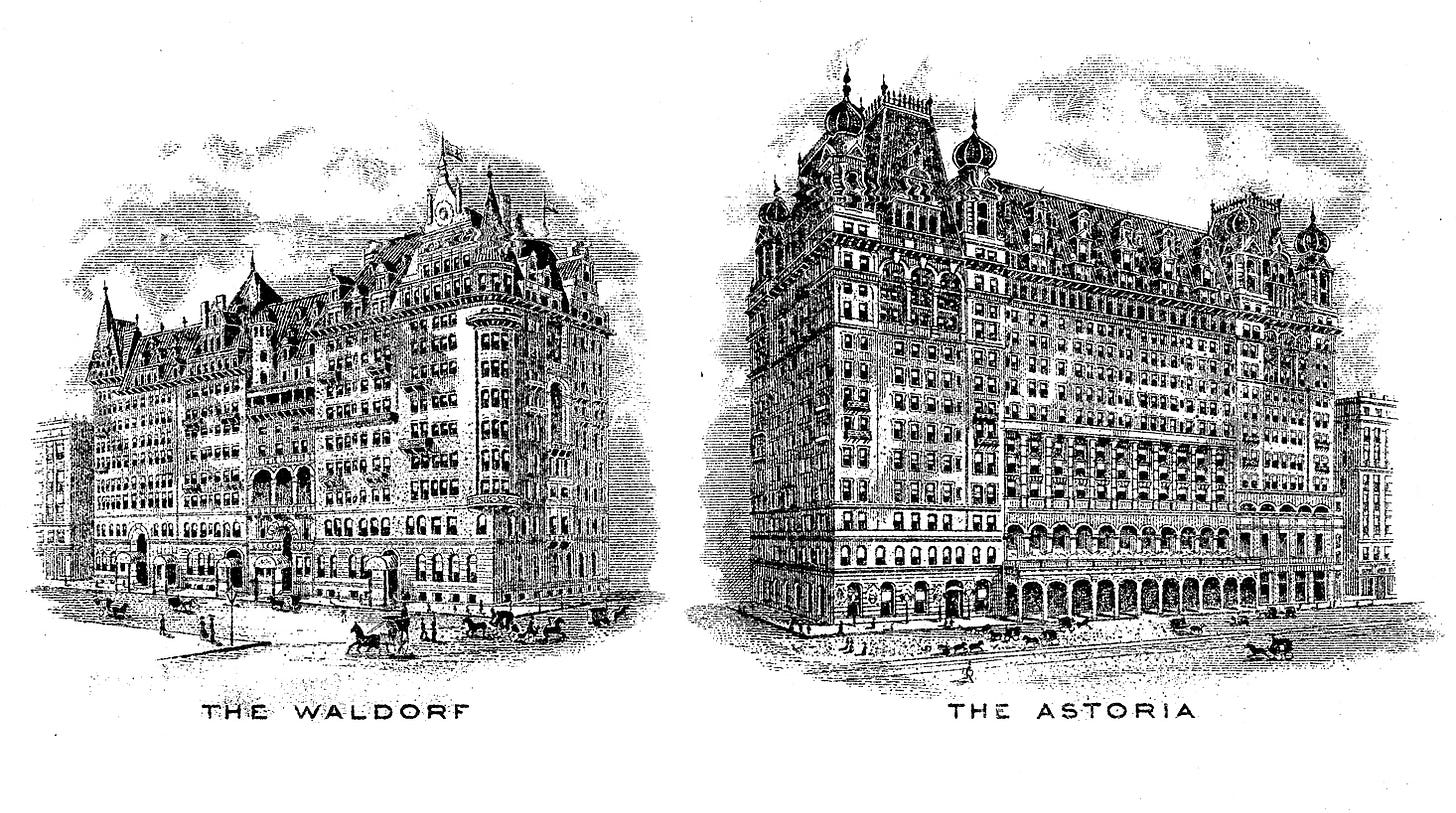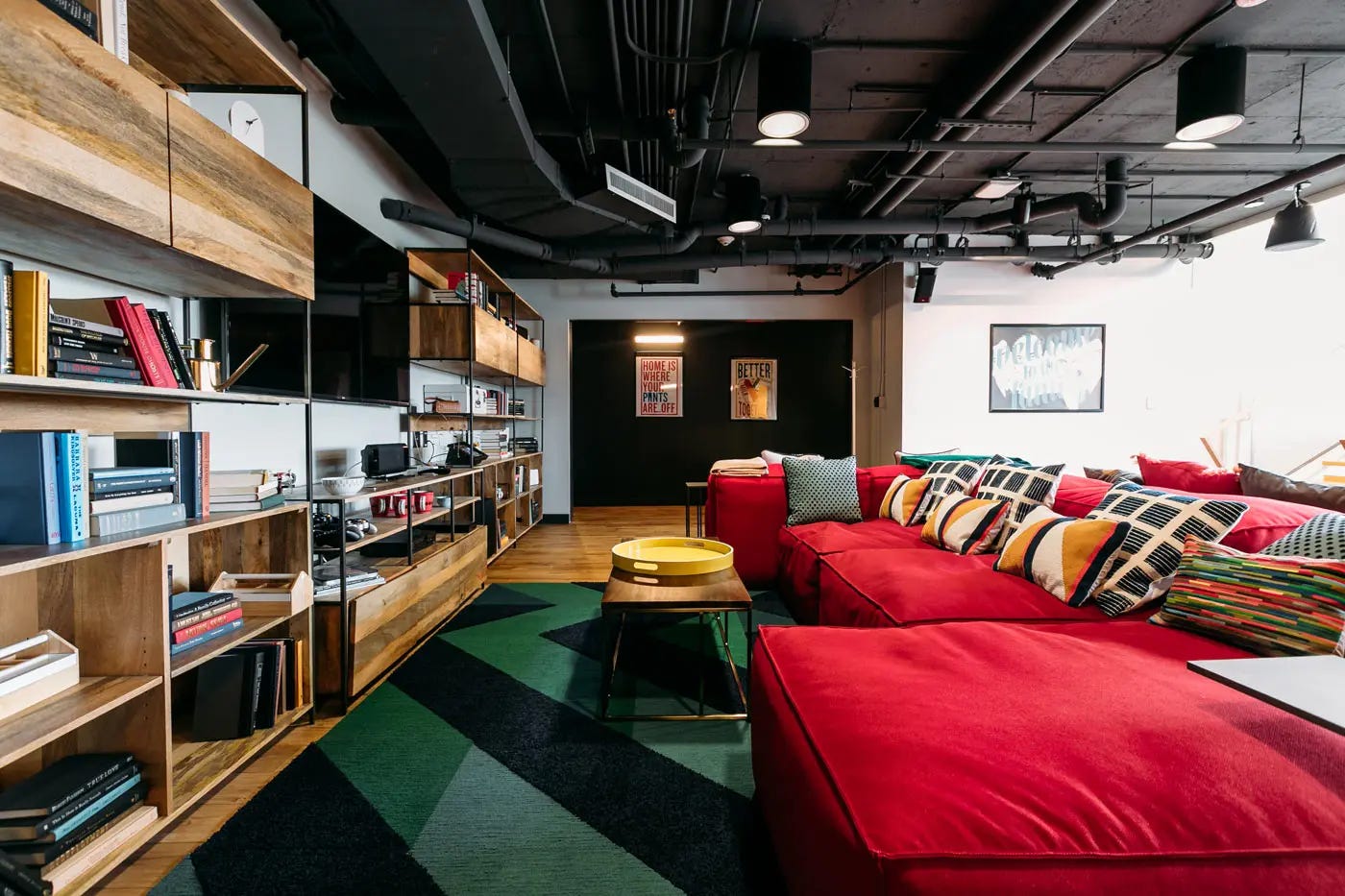Make Office Buildings Fun Again
A new report boosts the idea of converting office buildings to co-living
Hi readers old and new: In this article, I’m revisiting the topic of converting offices into co-living since it’s gaining attention with a new report from the NYC think tank, 5BORO Institute. Later this week I’ll have another article on cities that are taking nature seriously (behind the paywall).
I’ve also recapped last week’s D.C. event and shared the details of the November Boston event for paid subscribers here.
Like, subscribe, comment, please! 🙏❤️
Back in May, I wrote about a Carlo Ratti and Ed Glaeser op-ed in the New York Times coining a term, the Playground City. The Playground City would be one that thrives by offering pleasurable activities rather than job opportunities: tourism, going out to restaurants, other forms of recreation. While I didn’t agree with the premise of the Playground City, one aspect of their prescription for cities jumped out at me.
Deep-core office buildings could be converted into new kinds of spaces optimized for co-living and co-working. Bedrooms, with windows, could line the perimeter while common areas for cooking, laundry, work, exercise and socializing could fill the middle. Such arrangements could also help meet one of the social challenges of our time: loneliness.
I’m excited to see that this idea is garnering attention with a new report that I’ll discuss below, since I completely agree: co-living could be a great solution for cities trying to reimagine their office spaces.
For those not familiar with co-living, it’s a shared living model that fosters an intentional community through shared spaces and activities. Whereas in the past most people viewed communal amenities as a drawback, co-living makes those communal dinners, classes, and living rooms the draw. This is especially appealing given the loneliness epidemic afflicting the country, affecting lower-income people more than rich, isolated people.
I write a lot about co-living in my book, Brave New Home, and have a deep appreciation of it. Co-living is a 21st-century interpretation of shared living styles that have been part of the American vernacular for generations. For example, at the turn of the 20th century, apartment hotels were very popular. They offered public dining rooms and housekeeping to short- or long-term residents and were seen by some as feminist housing, separating the drudgery of domestic life for women and reducing the boundaries between domestic and public life for women. The early 20th century also saw workforce housing grouped by industry— for example, an apartment building just for sailors or actors — and built camaraderie and shared identity through these living arrangements.
Co-living picks up on these legacies, but interprets shared living anew. In the 2010s, co-living was pitched to a young, work-hard/ play-hard demographic who appreciated full-service, low-friction, amenity-driven housing. For young people accustomed to instant gratification and craving a lifestyle that’s Instagram-worthy, co-living was a level up beyond an overpriced shared apartment full of IKEA.
So why am I writing about coliving in the past tense? Despite its great popularity and potential, co-living kind of died off during the pandemic. Several major operators merged or closed down, leaving just one major co-living operator in the U.S., Common. But co-living lives on in more independent operations in cities like San Francisco or San Juan. This maturation of the industry, and its potential to be reborn in office building conversions, opens an opportunity to rethink what co-living is and who it serves.
Co-living could be a great fix for the office conversion problem. The key challenge with converting office towers into residential units is that office buildings often have huge floorplates with one huge stack of plumbing located in the center. It is cost prohibitive to add additional plumbing stacks across buildings that are often 30+ stories and then carve out apartments. But this kind of plumbing could work for a co-living situation where there are communal bathrooms and kitchens.
Enter a report released last week by the New York think tank, 5BORO Institute, that looks at this potential with a model they call “Flexible Co-Living.” While it’s great that thinkers like Glaeser and Ratti (and myself) are calling for co-living, it’s important that organizations like 5BORO Institute are bringing data and advocacy to the idea.
Some key points from the report:
Co-living has the potential to double the number of housing units created from an office conversion, compared to conversions to studio apartments.
An analysis by the Furman Center at New York University found that the break-even rent necessary to develop a small housing unit with shared common facilities like kitchens and bathrooms would be 40 percent lower than the break- even rent to develop a small studio apartment.
Housing experts and developers consulted by 5BORO estimate that office conversions to co-living could be $100 to $300 per square foot less than conversions to traditional apartments.
Co-living would add to the housing options available to the roughly 40 percent of adult renters in NYC who are living with roommates and sharing multi-bedroom apartments.
Co-living could reduce the competition for multi-bedroom apartments, helping free them up for families.
The report also offers a few renderings such as the floorpans below that show how neatly co-living would fit into a typical office setting.


But co-living 2.0 doesn’t have to be aimed at that same young, affluent demographic of the past. Instead it could geared towards the 55+ crowd who have their AARP card but don’t need or can’t afford regular senior living. It could also work well as a new kind of long-stay hostel, perhaps catering to digital nomads, and people who are using Airbnb as their month-to-month rental. Universities, which already operate dorms like co-living housing, might consider how they can renovate office towers, creating a seamless work-live environment for students.
And there is also great potential for co-living to be a source of affordable housing, which many cities desperately need. Co-living can provide scalable single-room occupancy (SRO) units, creating housing for many more people than a traditional apartment building. As 5Boro Institute notes in their report, incentives for developers could be linked to providing affordable units.
Finally, I do think that co-living and co-working could be better aligned. There’s no need to totally wipe out the office aspect of office towers. In my book, I wrote about my experience visiting WeLive in downtown Manhattan, which was located in an office building with several floors dedicated to WeWork co-working. For all the media that knocked this concept as soulless, I actually found it refreshingly honest – so many people leave work and get back on their computers later on at night, but in their own lonely houses and apartments. Clearly many people want to work casually around others: cafes are overrun by people on their laptops seeking a sense of social community and serendipity while they work. Co-living and co-working combined in an urban setting makes so much sense, it’s strange that there’s not more of it already given that so many of us already blur the boundaries between life and work.










Your piece came at an interesting moment. Last week, I finished reading Atul Gawande's book "Being Mortal" in which he discusses housing innovations for seniors, even those going thru the last mile of their lives, pointing to the work of gerontologists like Bill Thomas and Karen Wilson and "senior housing" like Eden Alternative and New Bridge on the Charles. Their work reminded me of your writing about 19th Century Boarding Houses and Multigenerational Housing and got me back to rereading Brave New Home.
But there's a difference: the Thomas and Wilson housing for seniors provide autonomy and purpose, as well as the chance to engage with others. It's not merely a question of "co-living" but something closer to "co-action" as a way to remember the value we all have and can provide.
If one were to incorporate your idea about re-purposing office space so it can be used by the growing demographic of the old (and retired), one would also need to design it in ways in which those who live in these spaces can connect, find purpose and meaning -- to give back and do, not merely to survive. It's not merely a question of "making office building fun" -- although that ain't bad. It's making a building into a functioning eco-system...ideas to be developed, teams to be supported, autonomy to be encouraged, and isolation and loneliness pushed aside.
There's much more to think about. Perhaps you could invite a gerontologist to think with you (or on a collective zoom) about how housing (from old offices) might be refashioned and reprogrammed.
I rented at the Crystal City WeLive for three months while transitioning back to DC. It was great -- It felt like living in a combination of a West Elm showroom and a Marriott Residence Inn. Had it not been in the hand of Adam Neumann in his final days at WeWork, I feel concept could have had legs.